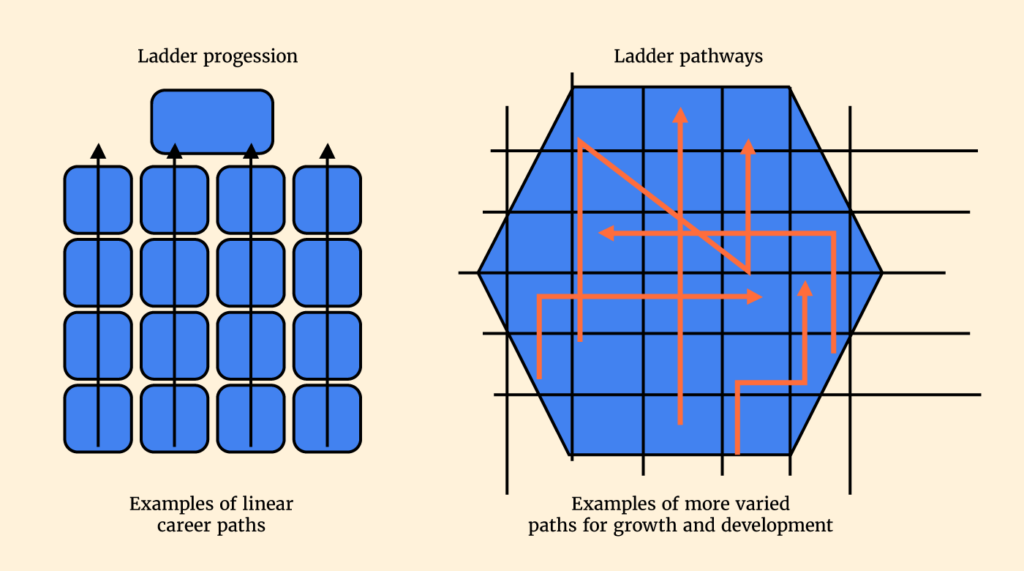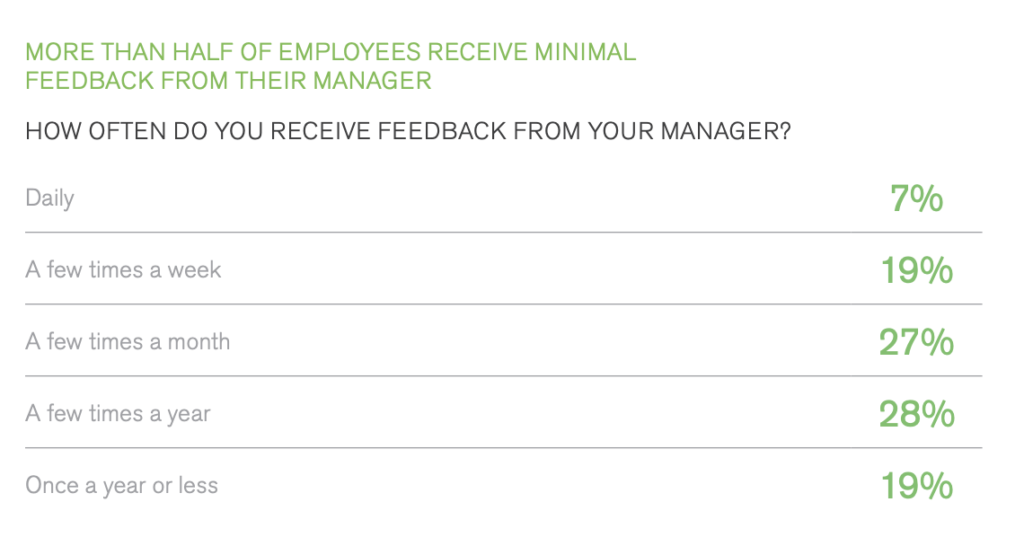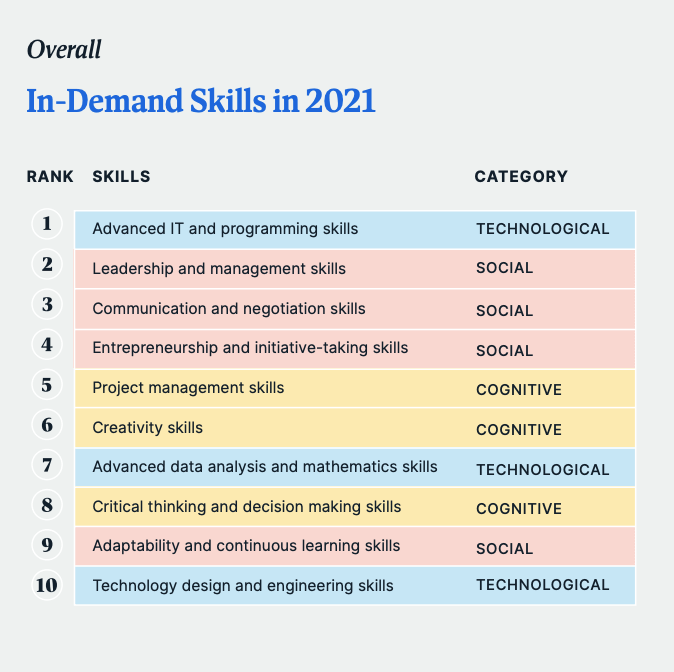It’s no mystery that career development is a top priority for employees but, according to Glint’s most recent Employee Well-Being Report, only 1 in 5 employees believe they can:
- Meet their career goals where they currently work; and
- Have both their manager’s and organization’s support to pursue those goals一even in another part of the business.
These figures doesn’t bode well for employee retention and engagement!
The reason we fail as employers to properly support employees in this regard is because, generally speaking, we have a tendency to view career development as a bonus for employees instead of a necessity for retention and for achievement of our strategic goals.
This result is that a lot of employees lack visibility into any potential next steps for their career advancement, which causes ambiguity and leads them to feel unsupported in their professional growth.
So, when it comes to offering our team members valuable career development opportunities, how do we stay in the game?
Carter Cast wrote in Harvard Business Review that we are now in the age of do-it-yourself career development. He says, “Ideally, organizations would do more to foster career advancement… but the reality is that the bigger burden is on employees. Workers at all levels must learn to identify their weaknesses, uncover their blind spots, and strengthen their skills.”
I believe we have to meet people in the middle. Creating visibility around opportunities for growth is a must for any organization, even (and especially) a growing one.
At Quantum Metric, we’ve been making changes to empower team members to take control of their professional development. So far, we’ve seen success with employees designing their own career maps and bringing them to their managers for collaboration.
This puts employees in the driver’s seat of their development, allowing them to focus their efforts on the skills that are of interest to them while creating alignment with broader business goals.
Sharing what we’ve learned, here are 5 best practices and methods to help support employees with their career development.
1. Make career progression a partnership between your organization and team members
As I mentioned, career progression is equally the responsibility of both your organization and team members themselves.
On your part, the first step is to be clear about what the company presently offers by way of tools and processes, and in what ways employees are expected to drive their own career growth.
If just beginning, you should be transparent about this exercise and start by offering frameworks around internal mobility, such as internal transfer policies and a performance management cadence whereby promotions and salaries are regularly reviewed.
Ultimately, the company should aim to publish departmental career paths for all to see in a company intranet or handbook.
In the meantime, proactively engage employees in conversations about their career aspirations.
We do a career session in our onboarding that sets realistic expectations about time in role and lets team members know how they can be successful if they’re after internal mobility.
In my conversations with team members, I emphasize that the slowest, most inefficient method of promotion is to wait for their manager to come to them with a fully formed next step. The most effective way is to identify a pain point or gap, and offer a solution!
2. Give your team members company time to devote to their career development
Managers should be encouraged to periodically check in on their team members’ development and aspirations during their regularly scheduled one on ones.
Consider guiding all managers to dedicate the last 15 minutes of their one on one meetings to asking development-focused questions, such as what work-related skill the employee would like to learn next.
Another idea is to allocate a set period of time per employee per week or month for them to devote to their own development.
This can be achieved by a company-wide mandate such as no meetings on Fridays afternoons, or can be established at the departmental level (for example, each employee in the marketing dept has 4 hours per month to schedule at their convenience for skill enhancement where they can block out their calendars and set their status to away).
At Quantum Metric, we recently rolled out a Career Development Lab, headed up by our incredible Head of Talent Development.
We offered an hour-long working session where we used various frameworks, assessments, and exercises to help employees reflect on their strengths and identify internal and external barriers.
We also provided a template for them to design their own career development plan in the form of career maps.
Each employee was then paired with a “career buddy”, whom they would schedule time with after the session to discuss their maps and action plan together.
We also used this opportunity to get insight into internal mobility and provided time for a Q&A. It was found that many of our employees need support on how to approach career conversations with their managers.
As a result, we are soon running a second Career Lab focused around actioning items from the first, and including practice role plays so that employees are equipped with the tools to broach these conversations.
3. Frame your internal conversations around options other than just promotion
A shift has been identified that the traditional career ladder is going away in favor of a more varied career lattice.
According to EDSI, a career lattice is “a flexible plan which supports employee development, upskilling and recognition in multiple directions and areas.”

Oftentimes, employees are fixated on moving upward into a management position without truly having a desire to take on more responsibility or manage—it just appears to be the only option available.
Help and encourage employees to explore other paths available to them that are aligned with their interests and the needs of the organization.
This could mean a lateral move to another part of the organization, promotion to a management position, or even an exploratory project with another department or job rotation.
Encouraging internal mobility is a great way to keep things fresh for people and help them learn new skills, especially if they’ve been in their current role for a while.
4. Equip all employees with the tools needed to have feedback conversations
Managers should be well-equipped to give employees feedback, and employees should be empowered to ask for it. And vice versa!
Feedback should include conversations about development, next steps, and goals. But studies show that’s not the status quo in the workforce today:
- A Gallup study shows that only 26% of employees strongly agree that the feedback they receive is effective in helping them perform better.
- A recent Interact survey showed that 37% of managers that responded said that they’re uncomfortable having to give direct feedback about their employees’ performance if they think the employee might respond negatively to the feedback.
- Only 20% of employees strongly agree that they have recently talked with their manager about steps to reach their goals in the past six months, says Gallup.

These numbers show a significant missed opportunity to increase employee engagement and empowering them to drive their own development.
See if you can get a pulse on the culture of communication in your organization, be it through an engagement survey or a focus group.
Are employees receiving enough effective feedback from their managers? Training front-line managers on delivering effective feedback should be a top priority for all organizations.
Creating alignment between an employee’s professional goals and the needs of the business cannot be achieved without first equipping all employees with the tools for open, clear, honest communication.
Related reads:
5. Encourage upskilling in the knowledge, skills, and abilities that are in demand in your organization
Consider your strategic goals over the next few months, what will it take for your teams to achieve them?
Upskilling your workforce provides opportunities for your team members to develop their skill sets and helps the business to prepare for upcoming challenges.
Netflix’s former Chief Talent Officer and HR thought leader Patty McCord says, “I ask managers to imagine a documentary about what their team is accomplishing six months from now. What specific results do they see? How is the work different from what the team is doing today? Next, I ask them to think about the skills needed to make the images in the movie become reality.”
Degreed recently published a State of Skills report that details the most in-demand skills for 2021. You might consider a similar exercise for your organization or for each department based on your strategic goals.
Consider publishing a KSA matrix on the departmental level.

From here you can conduct a skills gap analysis to see where your lacking skills. This will inform hiring and learning and development activities.
Wrapping Up
With the competition for talent still high, employers are searching for increasingly strategic and creative ways to meet the talent needs of today.
Investing in employee career development is a great way to increase engagement and retention. You’ll have a better skilled, more motivated workforce and also it’s just a great feeling knowing that you’ve helped someone to grow.
There are plenty of ways to give employees the keys to driving their own career development. These should be in tandem with an organization's efforts to supply career pathways and opportunities for mobility.
This creates alignment between employees' career goals and the company’s strategic goals, and allows an opportunity for an organization to upskill it’s employees to meet future needs.
In order for such a partnership to be successful, there must be mutual trust between the organization and team members, and a company culture that empowers its team members.
All of the above steps required resources, energy, talent, and time, but so far we’ve found that the rewards of more engaged employees and increased employee retention have been worth the effort!
Other methods you might want to consider include mentorship programs and internal talent marketplaces.
Some further resources to help:
- How To Create A Learning And Development Strategy In 7 Steps
- Internal Mobility: Why It’s Important And How To Nurture It
- 10 Best Learning Management Systems (LMS)
- What Is Succession Planning? How To Develop Your Next Great Leaders
Subscribe to the People Managing People newsletter and receive regular content to help you progress in your career and build healthy, productive organizations.
For further support, join our community of HR and people leaders and get access to exclusive content to help you get your HR department off the ground and create more efficient processes.


